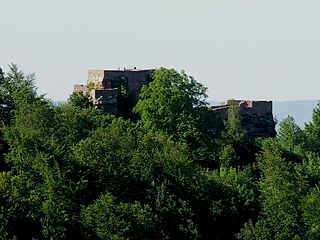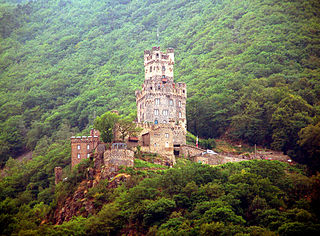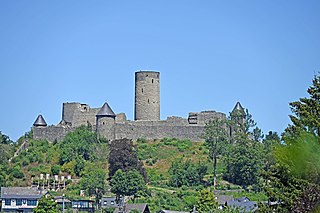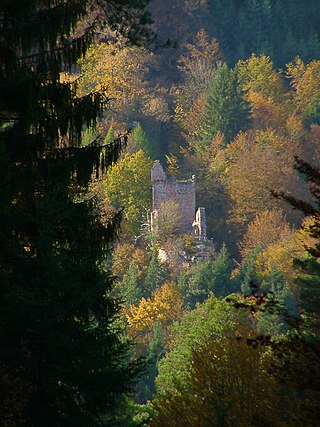
Nassau Castle, located in Nassau, Rhineland-Palatinate, Germany, was the original seat of the House of Nassau. The ruins of the castle are situated on a rock outcropping about 120 m (390 ft) above the Lahn River. The House of Nassau was an aristocratic dynasty among whose descendants are the present-day monarchy of the Netherlands and Luxembourg.

The Wegelnburg is a ruined castle near Schönau in the Palatinate Forest in Rhineland-Palatinate, Germany, near the border with France. Its location is at a height of 572m, making it the highest ruined castle in the Palatinate Forest.

Stolzenfels Castle is a former medieval fortress castle ("Burg") turned into a palace, near Koblenz on the left bank of the Rhine, in the state of Rhineland-Palatinate, Germany. Stolzenfels was a ruined 13th-century castle, gifted to the Prussian crown prince, Frederick William in 1823. He had it rebuilt as a 19th-century palace in Gothic Revival style. Today, it is part of the UNESCO World Heritage Site Upper Middle Rhine Valley.

The Hardenburg on the eastern edge of the Palatinate Forest near the Rhineland-Palatinate town of Bad Dürkheim is even as a ruin one of the mightiest castles of Palatinate.

Sooneck Castle is a castle in the upper middle valley of the Rhine, in the Mainz-Bingen district of Rhineland-Palatinate, Germany. It is located near the village of Niederheimbach between Bingen and Bacharach.

The Nürburg is a ruined hilltop castle in the German Eifel Mountains near the village of Nürburg south of Adenau in the district of Ahrweiler in the state of Rhineland-Palatinate. It stands within the famous North Loop, or Nordschleife, of the Nürburgring racing course at an altitude of 678 m (2,224 ft) on a volcanic basalt cone. It may be visited for a fee.

The castles of Dahn, near the little town of Dahn in the German state of Rhineland-Palatinate, consist of three rock castles:

Grafendahn Castle lies in the southern Palatine Forest, the German part of the Wasgau region, just under 1 kilometre east of the small town of Dahn in the state of Rhineland-Palatinate.

Tanstein Castle is the ruin of a rock castle in the southern Palatine Forest, the German part of the Wasgau region. It lies just under a kilometre east of the small town of Dahn in the state of Rhineland-Palatinate.

The rock castle of Neudahn, in the southwestern Palatine Forest in the German state of Rhineland-Palatinate, is located at the northern end of an elongated ridge near the town of Dahn. The heart of the castle is situated on one of the sandstone rock outcrops that are typical of the Dahner Felsenland region.

Kehrdichannichts Lodge is a former hunting lodge in the Palatine Forest west of Bad Dürkheim in the German state of Rhineland-Palatinate. It belonged to the Leiningen counts.

Murrmirnichtviel Lodge, alternatively spelt Murr-mir-nicht-viel, occasionally Murmel-nicht-viel, is a ruined hunting lodge with a watchtower that used to belong to the counts of Leiningen. It lies in the Palatine Forest southwest of the county town of Bad Dürkheim in the German state of Rhineland-Palatinate.

Schaudichnichtum Lodge was a former hunting lodge southwest of the town of Bad Dürkheim in the German state of Rhineland-Palatinate. Like its near neighbours, Kehrdichannichts, Murrmirnichtviel and Jägerthal, it was used as accommodation for the nobility of the Electoral Palatinate during the 18th century when they went hunting in the Palatine Forest.

The ruins of Breitenstein Castle stand on a crag, 220 metres (720 ft) high, on the northern side of the Speyerbach valley in the Palatine Forest in Germany. The castles is 4 kilometres (2.5 mi) east of the village of Elmstein in the county of Bad Dürkheim in the state of Rhineland-Palatinate.

Guttenberg Castle is a ruined rock castle near the French border in the German part of the Wasgau, which in turn is part of the Palatine Forest in the state of Rhineland-Palatinate.

Old Wolfstein Castle, is a ruined hillside castle on the eastern slopes of the Königsberg at the narrowest point in the Lauter valley near Wolfstein in the county of Kusel in the German state of Rhineland-Palatinate.

The Kasselburg is a ruined hill castle on a 490-metre-high basalt massif in Pelm near Gerolstein in the county of Vulkaneifel in the German state of Rhineland-Palatinate.

The Niederburg at Kobern, also called the Niedernburg, Unterburg or Neue Burg, is a hill castle above the municipality of Kobern-Gondorf in the county of Mayen-Koblenz in the German state of Rhineland-Palatinate.

The Oberburg at Kobern, also called the Oberburg or Altenburg, is a hill castle above the municipality of Kobern-Gondorf in the county of Mayen-Koblenz in the German state of Rhineland-Palatinate.


















